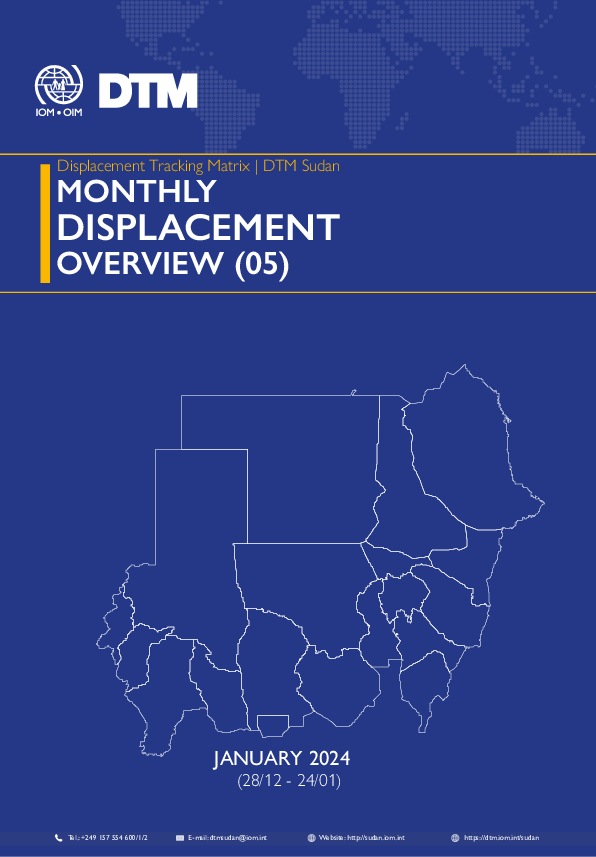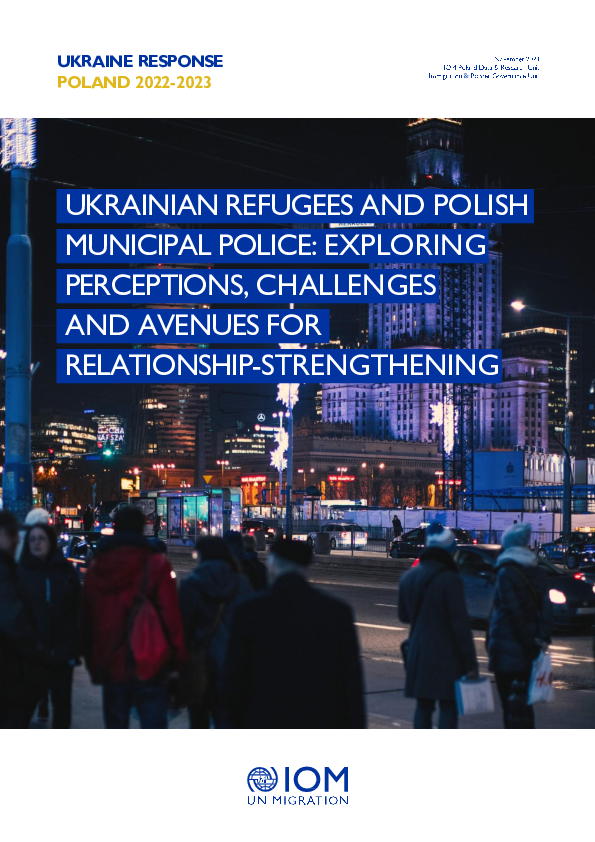-
Countries
-
Data and Analysis
-
Special Focus
-
Crisis Responses
Assessment Report

Contact
DTM Europe, DTMMediterranean@iom.int
Language
English
Location
Serbia
Period Covered
Dec 15 2023
Dec 29 2023
Activity
- Survey
- Flow Monitoring
This report provides insights into the profiles, experiences and journeys of migrants transiting through the Republic of Serbia. Data was collected from 15 to 29 December 2023 together with the Commissariat for Refugees and Migrants of the Republic of Serbia (SCRM). Total of 112 migrants were interviewed in six centres (AC Banja Koviljaca, RC Pirot, AC Obrenovac, RC Bujanovac, AC Krnjaca, RC Presevo) across the country.

Contact
DTM Europe, DTMMediterranean@iom.int
Language
English
Location
Hungary
Period Covered
Jan 01 2023
Dec 31 2023
Activity
- Survey
- Return Intention
- Flow Monitoring
The Crossing Back surveys conducted between January-December 2023 focused on individuals crossing back to Ukraine from or through Hungary, either for the short-term or long-term. For the purpose of the analysis, ‘’short-term visitors’’ are those who intended to spend 0-30 days in Ukraine, while respondents intending to stay for more than one month are labelled as “prospective returnees”.
The analysis of the survey participants’ marital status revealed a diverse range of relationship statuses. In total, over 61 per cent of the surveyed nationals identified as married, while 18 per cent of them reported to be single. Additionally, 12 per cent indicated being in a partnership, six per cent were widowed, and two per cent divorced. In 2023, the highest proportion of men were married (70%), followed by those who were single (17%) and those in partnerships (6%). Among women, a similar trend was recorded, as 59 per cent were married and 19 per cent were single. However, a higher proportion (13%) reported to be in partnerships, surpassing the equivalent figure for men.
Among the 1,253 survey participants, 76 per cent (N=948) were Ukrainian nationals, and 24 per cent (N=305) were Third-Country nationals (TCNs) with residence in Ukraine. The present analysis is derived from the responses of the Ukrainian participants.

Contact
DTM Sudan; dtmsudan@iom.int
Language
English
Location
Sudan
Period Covered
Jan 26 2024
Feb 02 2024
Activity
- Mobility Tracking
- Baseline Assessment
Overview
From 15 April 2023, armed clashes erupted between the Sudanese Armed Forces (SAF) and the Rapid Support Forces (RSF) in multiple cities across Sudan. Clashes initially took place in cities across Northern and Khartoum states, later spreading across the Darfur and Kordofan regions.
Highlights
- DTM Sudan estimates that 6,144,363 (1,224,269 Households) were recently internally displaced.
- The IDP caseload was observed in 6,594 locations across all of Sudan’s 18 states.
- The highest proportions of IDPs were observed across South Darfur (12%), River Nile (11%), East Darfur (11%), White Nile (8%), North Darfur (8%), Northern (7%), and Sennar (7%).
- Field teams reported that the IDPs observed were originally displaced from twelve states. The majority (3,522,784 IDPs, 57%) were reportedly displaced from Khartoum state; followed by South Darfur (15%), North Darfur (8%), Aj Jazirah (7%), Central Darfur (4%), West Darfur (3%), East Darfur (1%), South Kordofan (1%), West Kordofan (<1%), North Kordofan (<1%), Sennar (<1%), and White Nile (<1%).
- IOM-DTM also reported that an estimated 1,780,295 mixed cross-border movements were made into neighbouring countries.
- This product provides brief insights into those displaced in Sudan post-15 April 2023. For more granular information on the IDP caseload and the displacement context, please see IOM-DTM's Monthly Displacement Overview (05).

Contact
RDH Asia and the Pacific Support - rdhroapsupport@iom.int
Language
English
Location
Afghanistan
Period Covered
Aug 15 2021
Aug 15 2023
Activity
- Flow Monitoring
From when the reporting period started to where it ends, (15 August 2021 to 15 August 2023), the gap between total outflows and inflows has dwindled between Afghanistan and two of its neighbouring countries, that is the Islamic Republic of Iran and Pakistan.
By the second half of the reporting period, cross-border movements reached close to a 1 to1 ratio between outflows (4,307,755) and inflows (4,314,442).
Changes in these flows across this two year period may be more generally attributed to the combination of tighter governmental controls on border crossings, temporary border closures, and fear of deportations of Afghan nationals living abroad. The following sections point to notable peaks and downturns in mobility flows to help put into perspective the timeline and context in which IOM operates in.

Contact
DTM Europe, ROViennaDataResearch-Newsletter@iom.int
Language
English
Location
Republic of Moldova
Period Covered
Feb 01 2023
Jun 30 2023
Activity
- Survey
- Return Intention
The onset of the war in Ukraine has caused substantial displacement of people both within the Republic of Moldova’s borders and throughout the neighbouring region. The refugee situation is coupled with significant movement flows of Moldovan labour migrants returning from abroad, in particular from Ukraine, the Russian Federation, and other neighbouring countries. The effects of the Ukraine crisis, combined with the lingering consequences of the COVID-19 pandemic could potentially change the Republic of Moldova’s migration dynamics, leading to a decrease in emigration and an increase in the number of Moldovan citizens returning home.
This may have severe long term effects on the already strained Moldovan economy hindering its capacity to respond to the humanitarian and economic challenges attendant to the Ukrainian crisis. There are major gaps in data on Moldovan returnees, including information on their socio-economic profiles, needs and vulnerabilities as well as their intentions for their future. To fill those gaps the International Organization for Migration (IOM), as the leading inter-governmental organization promoting humane and orderly migration, has conducted a survey with Moldovan returnees in order to assess how the war in Ukraine has affected them.

Contact
DTM Sudan, DTMSudan@iom.int
Language
English
Location
Sudan
Period Covered
Dec 28 2023
Jan 24 2024
Activity
- Mobility Tracking
- Baseline Assessment
Overview
IOM DTM Sudan presents its fifth Monthly Displacement Overview. This publication provides an account of Sudan’s displacement context since 15 April 2023 – outlining population caseloads and movements, as well the present and evolving needs of Sudan’s growing IDP caseload.
Rationale
Recognizing the need for more detailed insights into the IDP situation, including the priority needs, access to services, movement intentions, and demographic breakdowns of the affected population, DTM Sudan has undertaken a comprehensive review of our data collection tool. In collaboration with a wide range of internal and external stakeholders, we have developed a new tool to better inform humanitarian response operations, aligning with the DTM global methodology. Leveraging our extensive network of approximately 367 field-based enumerators and a robust system of over 3,094 key informants across the country, DTM has gathered data on IDPs across 6,547 locations, in 177 of Sudan’s 189 localities – across all of Sudan’s 18 states.
Key Findings
- DTM Sudan estimates that 6,092,788 Individuals (1,213,683) Households) have been recently internally displaced.
- IOM DTM also reports that an estimated 1,720,890 mixed cross-border movements have been made into neighbouring countries.
- Since 15 April 2023, 45 per cent of the IDP caseload sought refuge in the Darfur and Kordofan regions, whereas 55 per cent were observed across the Northern, Eastern, and Central states.
- The majority of the IDP caseload (67%) were seeking shelter with the host community.
- While food security remains the highest priority need, health and non-food items are also growing concerns.

Contact
DTM South Sudan, SouthSudanDTM@iom.int
Language
English
Location
South Sudan
Period Covered
Jan 01 2024
Jan 27 2024
Activity
- Survey
- Return Intention
On 27 January 2024, the IOM’s Displacement Tracking Matrix (DTM) in collaboration with WFP, ACTED, LWF, and Save the Children conducted a rapid intention survey in Renk TC and its adjacent area to understand the return intentions of the population, preferred destinations of return as well as reasons for choosing to remain in the transit center.

Contact
dtmlebanon@iom.int
Language
English
Location
Lebanon
Period Covered
Oct 10 2023
Jan 30 2024
Activity
- Mobility Tracking
- Baseline Assessment
Since October 8 there has been an increase in cross-border incidents between Israel and Lebanon, resulting in the displacement of people both within the South and elsewhere within the country. Since October 10, the Displacement Tracking Matrix (DTM) has been conducting the daily monitoring of population movements. The objective of the exercise is to inform preparedness and response planning.

Contact
DTMUkraine@iom.int
Language
English
Location
Ukraine
Period Covered
Jan 02 2024
Jan 11 2024
Activity
- Mobility Tracking
This report serves to identify the heating systems employed in Ukrainian households, presents the estimated prices of solid fuel items across different oblasts, and examines the methods and frequency of solid fuel collection by the Ukrainian population. The report investigates the current and future demand, supply, and prices of essential solid fuel products. The overarching objective is to support ongoing humanitarian winterization operations.
Between 2 and 11 January 2024, the Data and Analytics (D&A) team surveyed 287 markets in 23 oblasts and Kyiv City in Ukraine, conducting face-to-face and remote interviews with both local vendors and community focal points (CFPs). In each oblast, data was collected in at least two locations, one urban and one rural and/or near frontline locations, where applicable. In each location, a minimum of two vendors and two CFPs (non-vendors) were surveyed. The CFPs were chosen based on their familiarity with the subject matter and knowledge of winterization preparation at the community level.

Contact
DTM Poland: IOMDTMPoland@iom.int
Language
English
Location
Poland
Period Covered
Oct 09 2023
Nov 10 2023
Activity
- Survey
- Community Perception
As of December 2023, more than 6 million refugees from Ukraine have fled to other countries because of the war which began in February 2022. More than 950,000 of these refugees are living in neighboring Poland. With this sudden influx of refugees, Polish society and institutions responded quickly to support their new Ukrainian arrivals through initiating social protection programs, collective site housing, and providing immediate assistance to those entering through the borders with Ukraine. Polish law enforcement – including the Polish border guard, police, and municipal police – played a key role in supporting Ukrainian refugees.
As the conflict continues and as many refugees have now lived in Poland for over a year, there is a need for research and programming on the various aspects enabling durable solutions – one of these being the ways in which Ukrainian refugees interact with and perceive Polish law enforcement. Even before the onset of the war there was a sizable Ukrainian population in Poland, meaning that Polish law enforcement officers’ interactions with and perceptions of Ukrainians may include both refugees who arrived after and migrants who arrived before February of 2022. From the law enforcement perspective, it can be challenging to distinguish whether an individual is a refugee, so for this reason our research also touches on the perceptions and experiences of Ukrainian migrants who resided in Poland before the war began (e.g. those who lived in Poland prior to February of 2022). This study aims to provide insights into the interactions, perceptions, and potential areas for improvement in the relationship between Ukrainians in Poland (with a focus on the refugee population) and Polish law enforcement (specifically focusing on Polish municipal police). The report covers IOM’s main research findings as well as recommendations both for Polish law enforcement’s engagement with Ukrainian communities and for future humanitarian programming.
Pagination
- Previous page
- Page 52
- Next page
